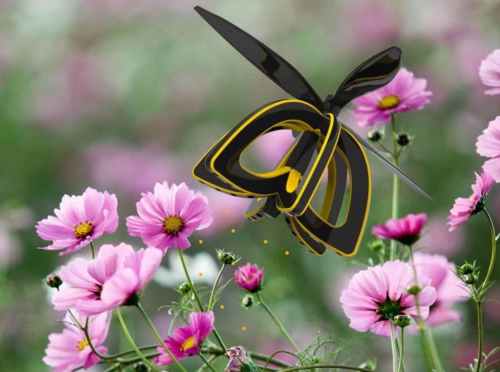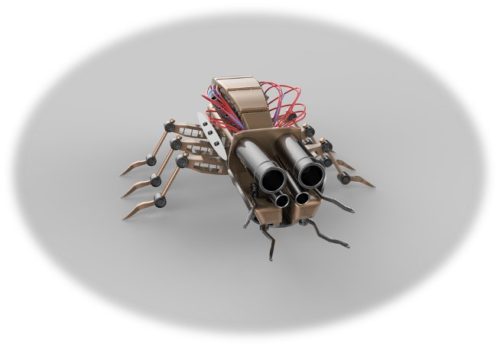 Purdue University - Extension - Forestry and Natural Resources
Purdue University - Extension - Forestry and Natural Resources
Got Nature? Blog
A drone can be defined in a myriad of ways. A constant humming sound can be called a drone. Your professor going over a lecture you find boring can be described as droning on and on about a particular topic. That friend of yours with the uncanny ability to come by your place to eat right at dinnertime but never offers to pay for the food is also a drone. In nature, male bees are also known as drones. These insects, the products of unfertilized eggs have an easy but vital role within the hive; mate with the queen. In technology, a drone is a remote-controlled aircraft either publicly available (those who fly them are termed ‘enthusiasts’) or held by the military that that has dramatically increased in popularity over the last decade. What happens when drone bees and remote-controlled drones meet?
Researchers in Japan have come up with an inventive pollination plan. As bees continue to die out, insect sized drones are being used to pollinate lilies. The miniature robots are covered in horse hair and a sticky gel that allows pollen picked up from one plant to be deposited on another. By no means a solution to the global decline in insect pollinators, these robots are working to help alleviate the demands placed on bee colonies to ensure adequate pollination of agricultural crops.
 The creative ‘bug’ has reached the industrial design field where 24-year-old senior Anna Haldewang (Savannah College of Art and Design, Georgia) developed Plan Bee. Rather than being the size of the bee, this black-and-yellow drone is the size of hand and resembles a flower. Plan Bee passes over flowers collecting pollen for later cross-pollination. Haldewang has filed a patent application and is roughly two years from having a product for the market. The primary role of Plan Bee is as an educational tool, however, hydroponic and large-scale applications may also be possible.
The creative ‘bug’ has reached the industrial design field where 24-year-old senior Anna Haldewang (Savannah College of Art and Design, Georgia) developed Plan Bee. Rather than being the size of the bee, this black-and-yellow drone is the size of hand and resembles a flower. Plan Bee passes over flowers collecting pollen for later cross-pollination. Haldewang has filed a patent application and is roughly two years from having a product for the market. The primary role of Plan Bee is as an educational tool, however, hydroponic and large-scale applications may also be possible.
 In addition to efforts of the Japanese groups, a research group in Maryland has taken the bee drone one step further. This group, led by Sarah Bergbreiter and her colleagues from the Maryland Microrobotics Laboratory at the University of Maryland, College Park has built tiny, microelectromechanical systems (MEMS) devices that look like and share the same movement as other insects such as fleas and ants. This group hopes to use their tiny robots to evaluate bridges and other structures for breakdown and search for survivors after a natural disaster.
In addition to efforts of the Japanese groups, a research group in Maryland has taken the bee drone one step further. This group, led by Sarah Bergbreiter and her colleagues from the Maryland Microrobotics Laboratory at the University of Maryland, College Park has built tiny, microelectromechanical systems (MEMS) devices that look like and share the same movement as other insects such as fleas and ants. This group hopes to use their tiny robots to evaluate bridges and other structures for breakdown and search for survivors after a natural disaster.
The moral of the story is, when you see a bee hard at work, appreciate the job it’s doing to ensure that our crops are fertilized, our flowers are pollinated, and we have honey to eat.
Literature Cited:
Chechetka et al. 2017. Materially engineered artificial pollinators. Chem 2, 224–239.
AVS: Science Array Technology of Materials, Interfaces, and Processing. Insect-like microrobots move just like real insects. ScienceDaily, 7 November 2016.
Web Resources:
This ‘bee’ drone is a robotic flower pollinator, CNN Tech
Biometric Trees: A Shockingly Cool Development, Got Nature?, Purdue Extension-FNR
Consider Pollinators When Planning Your Garden, Got Nature?, Purdue Extension-FNR
Shaneka Lawson, USDA Forest Service/HTIRC Research Plant Physiologist/Adjunct Assistant Professor
Purdue University Department of Forestry and Natural Resources

Recent Posts
- Report Spotted Lanternfly – Purdue Landscape Report
Posted: April 10, 2024 in Alert, Forestry, Invasive Insects, Plants, Wildlife, Woodlands - Declining Pines of the White Variety – Purdue Landscape Report
Posted: in Alert, Disease, Forestry, Plants, Wildlife, Woodlands - Are you seeing nests of our state endangered swan? – Wild Bulletin
Posted: April 9, 2024 in Alert, Forestry, How To, Wildlife - Cicadas in Spring! – Purdue Landscape Report
Posted: in Forestry, Plants, Safety, Wildlife - New Deer Impact Toolbox
Posted: April 7, 2024 in Forestry, Land Use, Plants, Publication, Safety, Wildlife, Woodlands - 2024-25 Fishing Guide now available – Wild Bulletin
Posted: April 4, 2024 in Alert, Aquaculture/Fish, Aquatic/Aquaculture Resources, How To, Ponds, Wildlife - Help Research Chronic Wasting Disease – Wild Bulletin
Posted: April 3, 2024 in Disease, Forestry, How To, Safety, Wildlife, Woodlands - Indiana Reptiles and Amphibians – IFWOA Webinar
Posted: April 1, 2024 in Forestry, How To, Webinar, Wildlife, Woodlands - Birding through the Seasons – IFWOA Webinar
Posted: in Forestry, How To, Webinar, Wildlife, Woodlands - Look Out for Invasive Carp in Your Bait Bucket – Wild Bulletin
Posted: March 31, 2024 in Alert, Aquaculture/Fish, Aquatic/Aquaculture Resources, Invasive Animal Species, Wildlife
Archives
Categories
- Alert
- Aquaculture/Fish
- Aquatic/Aquaculture Resources
- Ask the Expert
- Christmas Trees
- Community Development
- Disease
- Drought
- Forestry
- Forests and Street Trees
- Gardening
- Got Nature for Kids
- Great Lakes
- How To
- Invasive Animal Species
- Invasive Insects
- Invasive Plant Species
- Land Use
- Natural Resource Planning
- Nature of Teaching
- Plants
- Podcasts
- Ponds
- Publication
- Safety
- Timber Marketing
- Uncategorized
- Urban Forestry
- Webinar
- Wildlife
- Wood Products/Manufacturing
- Woodland Management Moment
- Woodlands
